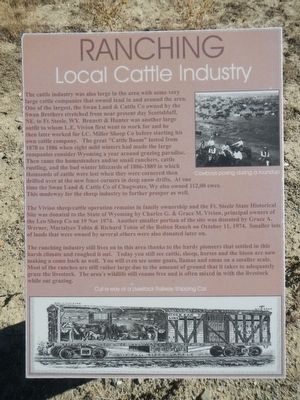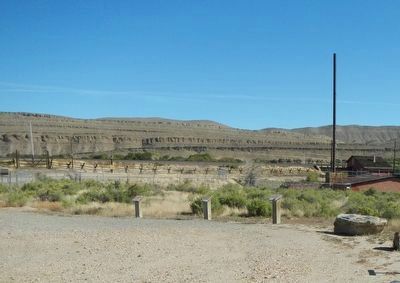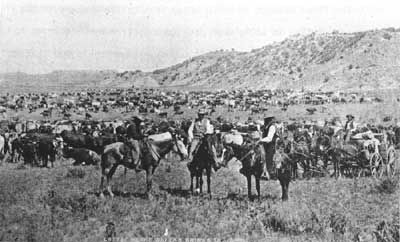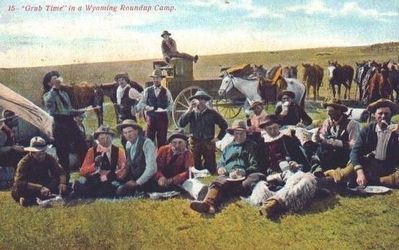Near Sinclair in Carbon County, Wyoming — The American West (Mountains)
Ranching
Local Cattle Industry
Inscription.
The cattle industry was also large in the area with some very large cattle companies that owned land in and around the area. One of the largest, the Swan Land & Cattle Co. owned by the Swan Brothers stretched from near present day Scottsbluff, NE to Ft. Steele, WY. Bennett & Hunter was another large outfit to whom L.E. Vivion first went to work for and he then later worked for I.C. Miller Sheep Co. before starting his own cattle company. The great "Cattle Boom" lasted from 1878 to 1886 when eight mild winters had made the large companies consider Wyoming a year around grazing paradise. Then came the homesteaders and/or small ranchers, cattle rustling, and the bad winter blizzards of 1886-1889 in which thousands of cattle were lost when they were cornered then drifted over at the new fence corners in deep snow drifts. At one time the Swan Land & Cattle Co. of Chugwater, WY also owned 112,000 ewes. This made way for the sheep industry to further prosper as well.
The Vivion sheep/cattle operation remains in family ownership and the Ft. Steele State Historic Site was donated to the State of Wyoming by Charles G. & Grace M. Vivion, principal owners of the Leo Sheep Co. on 19 Nov. 1974. Another smaller portion of the site was donated by Grace A. Werner, Marialyce Tobin & Richard Tobin of the Bolton Ranch on October 11, 1974. Smaller lots of land that were owned by several others were also donated later on.
The ranching industry still lives on in this area thanks to the hardy pioneers that settled in this harsh climate and roughed it out. Today you still see cattle, sheep, horses and the bison are now making a come back as well. You will even see some goats, lamas and emus on a smaller scale. Most of the ranches are still rather large due to the amount of ground that it takes to adequately graze the livestock. The area's wildlife still roam free and is often mixed in with the livestock.
Erected by Wyoming Recreation Commission.
Topics. This historical marker is listed in these topic lists: Agriculture • Industry & Commerce.
Location. 41° 46.564′ N, 106° 56.794′ W. Marker is near Sinclair, Wyoming, in Carbon County. Marker is on County Route 347 near Interstate 80, on the right when traveling north. Touch for map. Marker is in this post office area: Sinclair WY 82334, United States of America. Touch for directions.
Other nearby markers. At least 8 other markers are within walking distance of this marker. Sheepherder's Community (here, next to this marker); Sheep Industry (here, next to this marker); Sheep Ranching (a few steps from this marker); Bridge Tender's House (about 400 feet away, measured in a direct line); Railroad and River (about 400 feet away); Brownsville and Benton (about 400 feet away); Carbon Timber Company (about 400 feet away); A Well Traveled Sawmill (about 400 feet away). Touch for a list and map of all markers in Sinclair.
More about this marker. This marker, among a grouping of a four markers, is located at Fort Fred Steele State Historic Site. The markers are on County Road 347, north of the Interstate 80 Exit 228 and south of the railroad tracks.
Also see . . . The Wyoming Cattle Boom, 1868-1886 - Wyoming Historical Society. It’s been often said that Wyoming’s cattle industry started by accident. That’s a bit of stretch, actually. As the tale goes, Seth Ward, a sutler to Fort Laramie, left cattle out to graze the open range in the winter of 1852-53 along Chugwater Creek north of what is now Cheyenne. He expected to find carcasses in the spring. Yet when he returned he found “the oxen,” as he called them, thriving. (Submitted on October 26, 2015, by Barry Swackhamer of Brentwood, California.)
Credits. This page was last revised on June 16, 2016. It was originally submitted on October 26, 2015, by Barry Swackhamer of Brentwood, California. This page has been viewed 357 times since then and 16 times this year. Photos: 1, 2, 3, 4. submitted on October 26, 2015, by Barry Swackhamer of Brentwood, California.



